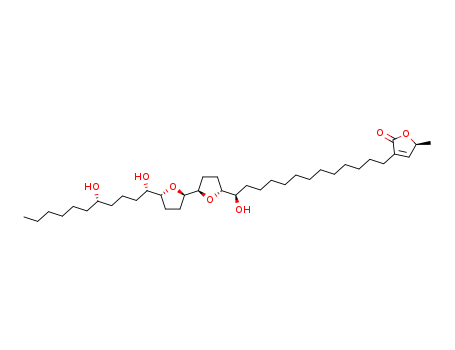Multi-step reaction with 16 steps
1.1: (R)-BINOL; mol sieves 4 Angstroem; Ti(OiPr)4 / CH2Cl2 / 1 h / 20 °C
1.2: 68 percent / CH2Cl2 / 120 h / -78 - -25 °C
2.1: 98 percent / imidazole / CH2Cl2; toluene / 20 °C
3.1: tetrahydrofuran / 18 h / 20 °C
4.1: NaOH; 30percent H2O2 / tetrahydrofuran / 5 h
5.1: 82 percent / pyridine / CH2Cl2 / 0 °C
6.1: 93 percent / LiBr / tetrahydrofuran / 32 h / 35 °C
7.1: Mg; BrCH2CH2Br / diethyl ether / 1 h / 35 °C
7.2: diethyl ether
8.1: 2,6-lutidine / CH2Cl2 / 2 h / -20 °C
9.1: 10percent Pd/C / propan-2-ol / 20 °C
10.1: (COCl)2; DMSO; Et3N / CH2Cl2 / -50 - 0 °C
11.1: NaClO2; NaH2PO4*2H2O; 2-methyl-2-butene / 2-methyl-propan-2-ol; H2O / 20 °C
12.1: LDA; LiCl / tetrahydrofuran / 0.5 h / 20 °C
12.2: tetrahydrofuran / 20 °C
13.1: pivaloyl chloride; Et3N / CH2Cl2 / 0.5 h / 20 °C
14.1: LDA / tetrahydrofuran / 0 °C
14.2: tetrahydrofuran / 2 h / 0 - 20 °C
15.1: monoperoxyphthalic acid / tetrahydrofuran; methanol / 0.5 h / 20 °C
16.1: 82 percent / HF (5percent in CH3CN) / tetrahydrofuran / 6 h / 20 °C
With
pyridine; 1H-imidazole; 2,6-dimethylpyridine; titanium(IV) isopropylate; sodium hydroxide; sodium chlorite; sodium dihydrogenphosphate; monoperoxyphthalic acid; 2-methyl-but-2-ene; oxalyl dichloride; 4 A molecular sieve; (R)-1,1'-Bi-2-naphthol; pivaloyl chloride; magnesium; dimethyl sulfoxide; ethylene dibromide; triethylamine; lithium chloride; lithium bromide; lithium diisopropyl amide;
10percent Pd/C;
In
tetrahydrofuran; methanol; diethyl ether; dichloromethane; water; isopropyl alcohol; toluene; tert-butyl alcohol;
1.1: Addition / 1.2: Substitution / 2.1: silylation / 3.1: Addition / 4.1: Oxidation / 5.1: Tosylation / 6.1: Bromination / 7.1: Metallation / 7.2: Grignard reaction / 8.1: silylation / 9.1: Hydrogenolysis / 10.1: Oxidation / 11.1: Oxidation / 12.1: Metallation / 12.2: Substitution / 13.1: Cyclization / 14.1: Metallation / 14.2: Substitution / 15.1: Oxidation / 16.1: desilylation;
DOI:10.1002/(SICI)1099-0690(200005)2000:10<1889::AID-EJOC1889>3.0.CO;2-R




